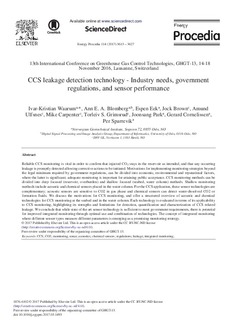CCS Leakage Detection Technology - Industry Needs, Government Regulations, and Sensor Performance
Waarum, Ivar-Kristian; Blomberg, Ann Elisabeth Albright; Eek, Espen; Brown, Jock; Ulfsnes, Amund; Carpenter, Mike; Grimsrud, Torleiv S.; Park, Joonsang; Cornelissen, Gerard; Sparrevik, Per
Peer reviewed, Journal article
Published version

View/
Date
2017Metadata
Show full item recordCollections
- NGI articles [1037]
Abstract
Reliable CCS monitoring is vital in order to confirm that injected CO2 stays in the reservoir as intended, and that any occurring leakage is promptly detected allowing corrective actions to be initiated. Motivations for implementing monitoring strategies beyond the legal minimum required by government regulations, can be divided into economic, environmental and reputational factors, where the latter is significant; adequate monitoring is important for attaining public acceptance. CCS monitoring methods can be divided into deep focused (reservoir, overburden) and shallow focused (seabed, water column) methods. Shallow monitoring methods include acoustic and chemical sensors placed in the water column. For the CCS application, these sensor technologies are complementary; acoustic sensors are sensitive to CO2 in gas phase and chemical sensors can detect water-dissolved CO2 or formation fluids. We discuss the motivations for CCS monitoring, and offer a structured overview of acoustic and chemical technologies for CCS monitoring at the seabed and in the water column. Each technology is evaluated in terms of its applicability to CCS monitoring, highlighting its strengths and limitations for detection, quantification and characterization of CCS related leakage. We conclude that while state of the art sensor technology is sufficient to meet government requirements, there is potential for improved integrated monitoring through optimal use and combination of technologies. The concept of integrated monitoring where different sensor types measure different parameters is emerging as a promising monitoring strategy.